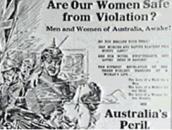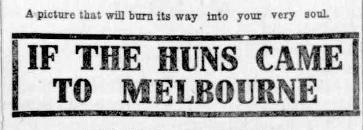AustLit
Latest Issues
AbstractHistoryArchive Description
A merchant marine ship is sunk off the coast of Australia by two marauding German cruisers, leaving one survivor, Jack Rawson. After drifting on a raft he lands on island and discovers is an enemy munitions base but is soon captured. After overhearing a plan to raid the Australian coast he manages to escape and eventually makes his way to Sydney. Before he can tell the authorities he is kidnapped by German spy Fred Smith (aka Frederich Schmidt). After tying Jack to a chair in a wooden building and setting fire to it Smith helps a German raiding party land near Sydney. As they begin to wreak havoc, Jack is rescued and helps fight the Germans, inspiring some workers who have gone on strike to join in the battle. When Jack becomes stranded behind enemy lines he discovers his fiancée, Marion is being held captive. He goes to rescue her and finds her being molested by Smith. Marion shoots Smith and kills him. The film ends with the couple being married.
Notes
-
Fo further details see Andrew Pike and Ross Cooper. Australian Film, 1900-1977 : A Guide to Feature Film Production (1980), p.89.
Publication Details of Only Known VersionEarliest 2 Known Versions of
Works about this Work
-
Anzac's 'Others' : 'Cruel Huns' and 'Noble Turks'
2009
single work
criticism
— Appears in: Diasporas of Australian Cinema 2009; (p. 93-102)'War films are not an obvious starting point to discuss Australia's diasporic cinema. Nevertheless, portrayals of the enemy draw attention to the nationalizing discourses which serve to maintain an assimilationist model of the nation. While neither German nor Turkish identities figure prominently in Australia's contemporary multicultural cinema, these national 'types' play a more significant role in Australian visual culture produced in the first part of the twentieth century. German, and to a lesser extent Turkish, villains feature in numerous films produced in Australia during both world wars. In this chapter, we argue that in the short term Australian film portrayals of the 'the cruel Hun' and 'noble Turk' encouraged glorification of soldiers in Australian and New Zealand Army Corps (ANZAC), while in the long term these perpetuated a more nationalistic construction of the Anzac legend' (Publication abstract)
-
Convention and Contradiction : Representations of Women in Australian War Films, 1914–1918
1999
single work
criticism
— Appears in: Australian Historical Studies , October vol. 30 no. 113 1999; (p. 215-230)'This paper examines the representation of women in Australian cinematic war dramas made between 1914 and 1918, showing how the representations were shaped by political, industrial and ideological influences and identifying the range of representations present in the films. It observes that while there was considerable overlap with other media in the representation of women, there were images ignored by films, while others were unique to the cinema.'
Source: Abstract.
-
Convention and Contradiction : Representations of Women in Australian War Films, 1914–1918
1999
single work
criticism
— Appears in: Australian Historical Studies , October vol. 30 no. 113 1999; (p. 215-230)'This paper examines the representation of women in Australian cinematic war dramas made between 1914 and 1918, showing how the representations were shaped by political, industrial and ideological influences and identifying the range of representations present in the films. It observes that while there was considerable overlap with other media in the representation of women, there were images ignored by films, while others were unique to the cinema.'
Source: Abstract.
-
Anzac's 'Others' : 'Cruel Huns' and 'Noble Turks'
2009
single work
criticism
— Appears in: Diasporas of Australian Cinema 2009; (p. 93-102)'War films are not an obvious starting point to discuss Australia's diasporic cinema. Nevertheless, portrayals of the enemy draw attention to the nationalizing discourses which serve to maintain an assimilationist model of the nation. While neither German nor Turkish identities figure prominently in Australia's contemporary multicultural cinema, these national 'types' play a more significant role in Australian visual culture produced in the first part of the twentieth century. German, and to a lesser extent Turkish, villains feature in numerous films produced in Australia during both world wars. In this chapter, we argue that in the short term Australian film portrayals of the 'the cruel Hun' and 'noble Turk' encouraged glorification of soldiers in Australian and New Zealand Army Corps (ANZAC), while in the long term these perpetuated a more nationalistic construction of the Anzac legend' (Publication abstract)
- Pacific Ocean,
-
cAustralia,c






